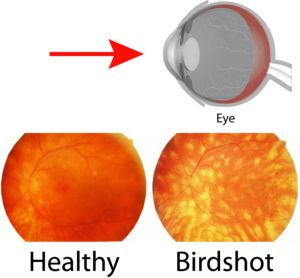Birdshot retinochoroidopathy
| Birdshot chorioretinopathy (HLA-A29 Uveitis) | |
|---|---|
| Synonyms | Multiple small, cream-colored lesions, symmetrically scattered mainly around the optic disk, Vitiliginous choroiditis |
 |
|
| Characteristic hypo-pigmentation in Birdshot Chorioretinopathy | |
| Specialty |
Ophthalmology |
| Classification |
· ·
|
|---|---|
| External resources |
Birdshot chorioretinopathy now commonly named "Birdshot Uveitis" or "HLA-A29 Uveitis" is a rare form of bilateral posterior uveitis affecting the eye. It causes severe, progressive inflammation of both the choroid and retina.
Affected individuals are almost exclusively caucasian and usually diagnosed in the fourth to sixth decade of their lives.
Symptoms of this disorder include floaters, blurred vision, photopsia (flashing lights in eyes), loss of color vision and nyctalopia. In an eye examination, light-colored spots on the retina are seen. Complete loss of visual acuity may happenThe name of the condition comes from the small light-colored fundus spots on the retina, scattered in a pattern like birdshot from a shotgun, but these spots might not be present in early stages.
Birdshot chorioretinopathy is a rare form of posterior uveitis and accounts for 1-3% of uveitis cases in general. Birdshot chorioretinopathy is thought to be an autoimmune disease. The disease has strong association with the Human leukocyte antigen haplotype (HLA)-A29, which is the strongest association between a disease and HLA class I documented (>99% of patients are HLA-A29 positive by molecular testing and HLA-A29-negative cases are controversial). This indicates a role for T-lymphocytes in the pathogenesis. Birdshot chorioretinopathy is associated with IL-17, a hallmark cytokine of TH17 cells that play an important role in autoimmunity . The disease affects typically middle-aged or elderly caucasians. HLA-A29 is less prevalent in Asia and no birdshot chorioretinopathy cases have been reported in Asia. When birdshot chorioretinopathy is suspected, a person is usually tested to determine if they are HLA-A29 positive. Although previously HLA-A29 testing was not considered necessary for definitive diagnosis, because HLA-A29 is also common in the general healthy population (7%). An increasing number of specialists consider the presence of HLA-A29 critical for diagnosis. Additional (genetic or environmental) or unknown factors may be associated with HLA-A29 in the pathogenesis.
...
Wikipedia
